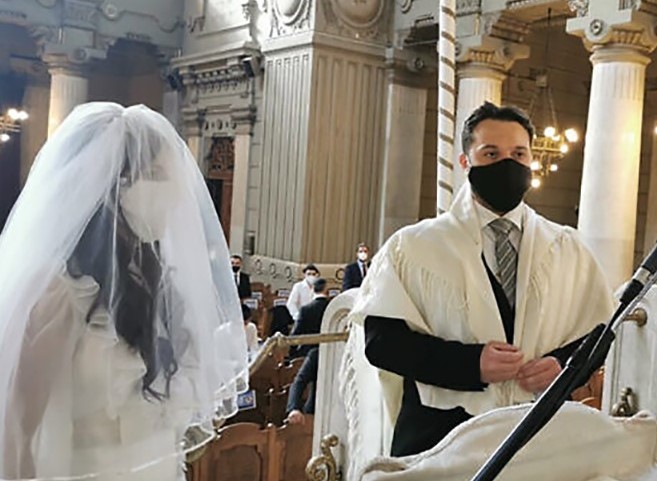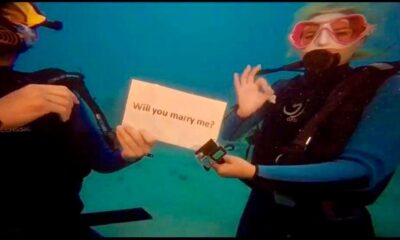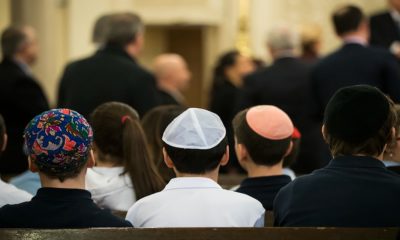
Featured Item

COVID-risky simchas ‘like Russian Roulette’
As COVID-19 numbers remain low, many young Jewish couples are taking the opportunity to get married. But at every simcha, one can see social media and livestream images of maskless retinues and guests, hugging, kissing, dancing, group selfies, large family photos, and Horah dancing. Even some rabbis aren’t wearing masks or keeping a social distance.
Wedding musicians, speaking on condition of anonymity, say it has become too much, and feel that COVID-19-safe simcha protocols need to be widely distributed and closely enforced for the safety of the community, wider population, and vendors who put their lives on the line every time they work at a wedding.
They say they have seen reckless behaviour by adults at many simchas. They are speaking out after a respected videographer landed up in hospital in January on oxygen, and a well-known bass player died from COVID-19 last year. They fear they’ll be next.
The performers say that on previous occasions, they have been pressurised by families to forget about COVID-19 rules. Some have been told that “COVID-19 is over” and that guests flying in from overseas (some of whom have been vaccinated) don’t need to wear masks, or that guests don’t need to abide by the curfew.
But when performing at Barmitzvahs and Batmitzvahs, they say that children and teens are stringent about wearing masks and keeping a distance, which shows that it’s possible to have a COVID-19-safe simcha.
“They all dance and eat apart. They really are leading the way. It’s like that campaign that told children to get their parents to ‘buckle up’. They choose to take it seriously. They don’t want to remember it as ‘when granny died because she caught COVID-19 at my Batmitzvah’,” says a performer.
They have witnessed some families thinking carefully about how to make a wedding joyful and safe. “For example, one mother of the bride got a guarantee from the retinue that they would quarantine for 10 days before the wedding and have COVID-19 tests two days before, and only they would dance at the wedding,” says another vendor.
A member of the community who attended a recent Jewish wedding in Cape Town, speaking on condition of anonymity, says, “When we walked in, everyone was sanitised and temperatures were taken. There were also masks at the door and kippot. People were mostly wearing masks, but as expected, they came off later in the night when people ate and drank and for photos. People were generally quite dispersed as there was an outside section, but I suppose I’d be lying if I said it was proper social distancing – a bit hard at a wedding.”
That may be the crux of the matter – having a COVID-19-safe wedding isn’t easy. And yet our community has been advised by top experts in the field to make it possible. Professor Efraim Kramer, who actually chose to cease advising the community because of its flouting of COVID-19 protocols, says the recommendations he wrote “are the standard wedding protocols that have always been in use [during the pandemic], irrespective of the COVID-19 level. The protocols were given to the Beth Din and any rabbi doing a wedding who wanted them. They are a public resource. All rabbonim are aware of the protocols, legislated precautions, and expert medical advice. They have the power and authority to ensure everybody is COVID-19 compliant for the chuppah ceremony, which they control. Whether they choose to exercise their power to ensure safety is the million-dollar question.”
In the document, Kramer sets out COVID-19-safe guidelines for all Jewish weddings during the pandemic. He recommends that each family should appoint a COVID-19 safety supervisor for the event. At the wedding, each person must go directly to a labelled chair with his/her name on it. They must remain in their seat for the entire ceremony, and wear an appropriate face mask at all times.
The protocols show that during a pandemic, a wedding must just be a chuppah – no dancing, eating, drinking, or socialising. But it’s clear that most weddings under COVID-19 don’t abide by these recommendations.
“Don’t socialise away from ones designated chair,” the protocols state. “Don’t bring food, drink, or alcohol into the premises except wine/grape juice for the chuppah. No dancing should be done at any time. No communal singing should be done at any time except the designated performer. Remain in your seat after the traditional glass has been smashed until the bride and bridegroom have left the chuppah area. You may clap at the appropriate time as often and as loud as you wish. Please leave the premises immediately after the wedding ceremony without any socialising.”
Kramer has also laid out protocols for every aspect of the wedding, from the pre-wedding reception to the bride and groom’s table, to the bedeken, chuppah, and civil-marriage registration. He also provides a “wedding kit” list – everything needed for a Jewish wedding in the COVID-19 era, including a medical screening register document.
Says Chief Rabbi Dr Warren Goldstein, “As a chuppah is a religious event, there are Beth Din-mandated health and safety protocols endorsed by our medical panel which have been communicated to the rabbonim and shul committees. Regarding private events, including wedding receptions and other simchas, we have strongly recommended and requested that people follow the Hatzolah health and safety guidelines for private gatherings. I joined in the Hatzolah video plea to our community to maintain caution and all protocols to prevent a third wave.”
If these protocols aren’t followed, the ramifications could be serious. Jeffrey Dorfman, associate professor in medical virology at Stellenbosch University, says, “The rate at which people are being diagnosed in South Africa with COVID-19 is low for the moment. However, that will surely change, although no one really knows when. When it does, we will only know after a delay, and the rise will be helped by super-spreader events – particularly in the early part of the rise. I appeal to people not to provide those super-spreader events.
“My colleagues in India are having an incredibly rough time, and when that variant makes it here, again our knowledge about it will be delayed,” he says. “Even for people who feel comfortable about relaxing their guard, that shouldn’t extend to large in-person events. Please, don’t contribute to a new wave, and don’t allow you and your loved ones to be hurt by it. Stay away from large in-person events.”
Professor Barry Schoub, emeritus professor in virology at the University of the Witwatersrand and the former director of the National Institute for Communicable Diseases, agrees that lower COVID-19 numbers aren’t a signal to relax vigilance.
“Being a respiratory spread infection, the coming cold winter weather may well herald the anticipated third wave. These precautions still apply equally to those who have been vaccinated. Particularly problematic are simchas, when many of us seem to lose our common sense and throw caution to the wind, risking tragic consequences.”
Kramer makes no bones about what these tragic consequences might be. “The COVID-19 pandemic is a classic case of Russian Roulette. Sometimes there are many bullets in the gun chamber, and sometimes there are few, but there are always bullets in the chamber. Remove COVID-19 precautions at mass gatherings, and you pull the trigger and wait to see if someone dies. To ignore standard precautions at these events is against the law, against expert medical advice, and against common sense. We cannot wish COVID-19 away, and sadly, because of our irresponsible behaviour, we will bring on the next COVID-19 tsunami. When it comes, we will only have ourselves to blame.
WEDDING PROTOCOL LIST
DIRECTIONS ISSUED IN TERMS OF REGULATION 37(1)(a) OF THE REGULATIONS ISSUED IN TERMS OF THE DISASTER MANAGEMENT ACT, 2002. (ACT NO. 57 OF 2002)
The Wedding will be undertaken according to the above Regulations and anybody allowed access to the Wedding should abide by these Regulations.
• If you are not feeling well now or in the last 7 days or been in contact with a Covid positive person within the last 7 days, please do not attend.
• Each person should report to the medical screening table, sanitize hands, have an infrared temperature recorded and complete the Wedding Attendance Register using a sanitized pen, as per the Regulations, which have not changed
• Each person shall proceed to a labelled chair with his/her name on it. Please remain in your seat and do not go where the Bride and Bridegroom are located, as to avoid social distancing problems.
• Always remain 2 metres social distancing from any person that you wish to engage socially or communicate with.
• Wear an appropriate face mask always, without exception.
• Do not move any chairs, that have been specifically located 2 metres from each other.
• Do not make any physical contact with anybody.
• Do not swap or exchange cell phones or other items, unless thoroughly sanitised.
• Do not bring food, drink, or alcohol into the premises except wine / grape juice for the Chuppah.
• No person to person contact dancing should be done at any time to avoid physical contact or decreasing social distancing.
• No communal singing, unless outside, should be done at any time except the designated performer to avoid spread of the Covid virus
• Remain in your seat after the traditional glass has been smashed until the Bride and Bridegroom have left the Chuppah area. You may clap at the appropriate time as often and as loud as you wish.
• Please leave the premises immediately after the wedding ceremony without any socialising.
The Kabbalat Panim – Pre-Wedding Reception / Bride Room, which is the traditional reception for the family and friends of the bride to gather in a location to wish the bride and each other a hearty mazeltov, should be avoided so as not to breach the Regulation requirements of 2 metre social distancing. If present, it should be done outside with strict 2 metre social distancing.
Bridegroom’s Room / Table, the traditional reception for the family and friends of the bridegroom to gather in a location to wish the bridegroom and each other a hearty mazeltov and sign the ketubah, should be avoided, so as not to breach the Regulation requirements of 2 metre social distancing. If present, it should be done outside with strict 2 metre social distancing. No alcohol is allowed.
Badeken – Veiling the Bride. Just before the Bridegroom approaches his Bride, all those present should move away from the Bride to allow 3 metre circumferential radius, to allow the Bridegroom to veil his Bride with adequate space and safety. Once this 3-metre social distance has been achieved, the Bridegroom may approach his Bride, the Brides face mask may be removed, and the Bridegroom may traditionally veil his Bride. From this point onwards, if a 3 metre radius of social distancing can be maintained until the Bride is positioned next to her Bridegroom under the Chuppah, including her
walk from the Bride’s Room to the Chuppah, with the exception of her accompanying parents, then she may remain with the veil in place without a face mask. However, if this 3 metre safety radius circumferentially cannot be maintained, for whatever reason (structural design, position of present attending persons, Bride not being accompanied by those with whom she resides etc), then she must wear her mask under her veil for safety.
Although it is medically advisable and government Regulations that everybody wear an appropriate face mask at all times at all mass gathering events, like a wedding, it is understandable and natural that the bride and bridegroom wish to have their faces uncovered, and of their respective parents as well, when each of them walk down the aisle to the Chuppah. If this is the chosen method, albeit it illegal and unhealthy, it is highly recommended that the following be considered in the interests of safety:
• The ceremony should only be undertaken outside to enhance ventilation
• Sanitise hands before beginning the respective walks down the aisle
• Ensure all guests are located at least 3 metres away from the sides of the aisle
• The bride and bridegroom should only be accompanied down the aisle by those who she/he has regular physical contact with, to avoid any potential viral spread
• Social distancing under the Chuppah has to be strictly adhered to by all parties if face masks are not worn
Chuppah
The maximum number of persons under and around the Chuppah must always maintain the safety regulations and considerations in place throughout the Wedding ceremony.
The following physical considerations should be maintained:
o The Bride and Bridegroom must sanitise their hands with 70% alcohol spray before the beginning of the Chuppah process.
o The Bride and Bridegroom may stand next to each other (without the need for any social distancing throughout).
o The officiating Rabbi, who will deliver the service verbally, read the Ketubah, announce the brachot, handle the becher (goblet) of wine and so forth, shall wear an appropriate face mask, throughout the Chuppah ceremony. He shall physically maintain a 2-metre circumferential distance from all other persons nearby except the Bride and Bridegroom where a 1 metre distance is maintained just during the ceremony.
o The accompanying witness to the ceremony shall wear an appropriate face mask throughout the Chuppah ceremony. They shall physically maintain a 2-metre circumferential distance from all other persons nearby, except the officiating Rabbi, where he can maintain a minimum distance of 1 metre circumferentially during the Chuppah ceremony only, for practical considerations that do not breach safety.
o The Bride and Bridegroom’s Fathers and Mothers shall stand to the side of the Bride, always at a 2-metre circumferential distance from all other persons nearby including the officiating Rabbi.
o Both sets of Mothers (or substitutes), who will assist the Bride in drinking from the cup of wine, shall sanitise their hands with 70% alcohol spray before doing so.
o There shall be no pole-holders as this is not a religious requirement and should therefore be discontinued during the Covid outbreak due to safety reasons. There is likewise no need for a best man.
o The relevant “ring” shall be sprayed with 70% alcohol sanitiser beforehand and sealed inside a clean Jiffy type plastic bag until it is required under the Chuppah. Besides tradition, it is recommended that the ring be kept by the Bridegroom’s father to decrease the number of persons under and near
the Chuppah.
o The wine for the Chuppah must be from an unopened bottle of wine. The Wine becher and the bottle of wine shall be sprayed with 70% alcohol sanitiser before the event and sealed inside a clean Jiffy type plastic bag until it is required under the Chuppah.
o The glass used for breaking should be treated in the same manner as the Becher.
o All activities from this point onwards require the need for social distancing of 2 metres, for safety reasons.
Civil Marriage Registration
It is recommended that the civil Marriage Certificate requirements be undertaken before the actual Chuppah ceremony at the office of the officiating Rabbi. Besides the relevant documentation necessary, two new ink pads should be purchased for fingerprint purposes for the Bride and Bridegroom.
Wedding kit
A pack of 6 x new pens for medical screening table / Ketubah signing
Spray bottles of 70% alcohol x 10
Named labels for guest seating
Ketubah inside container
Wine glasses x 3
Grape juice / Wine bottle x 1
Glass for smashing under Chuppah
Large Jiffy type transparent plastic bags for sanitised wine glasses, bottle of grape juice/ wine and glass for smashing.
Spare regulation face masks x 3
New ink pad for civil marriage fingerprints
Wedding attendance register, pre-populated with the full names, contact cell number, current infrared temperature, and any history in last 7 days with a Covid positive person or been ill.
Toilet Use
Be prepared to have limited access to the toilet. (If you absolutely need, you must disinfect the toilet after use. The toilet should be limited to only one person at a time).
Always hand sanitise hands on entering the toilet, before and after touching any doors, seats, handles etc.
Please sanitise or wash hands thoroughly on all hand, palm and between fingers and under nails with soap for 20 seconds minimum after toilet use.
The toilet seat should be closed before flushing to prevent potential spreading of the virus.
Paper towels / wall heater only will be used.
No personal items should be left in the toilet
People may not congregate and socialise in the toilet facility and area
All hand rinsing bowls should be removed for safety reasons.








